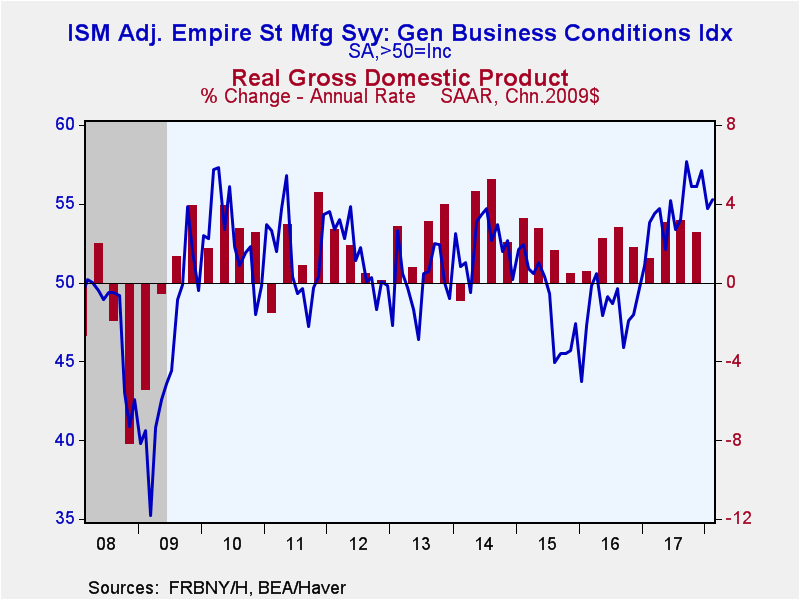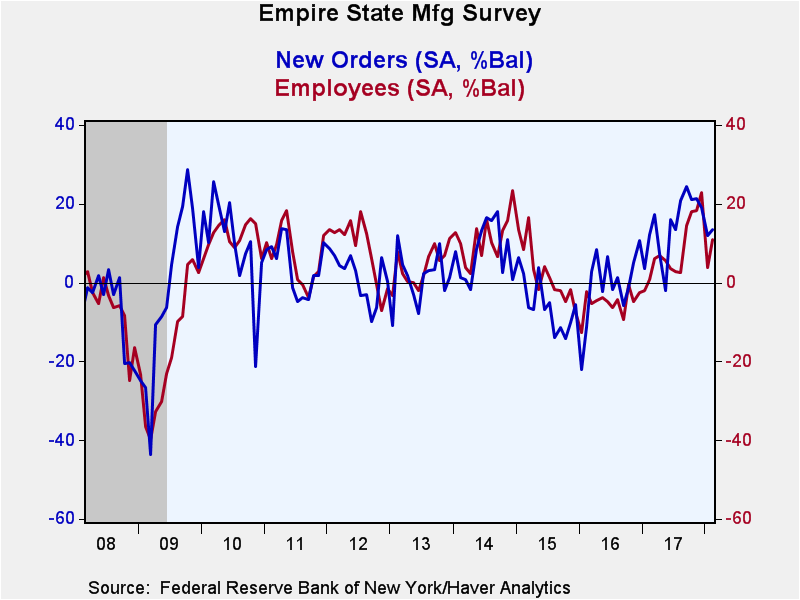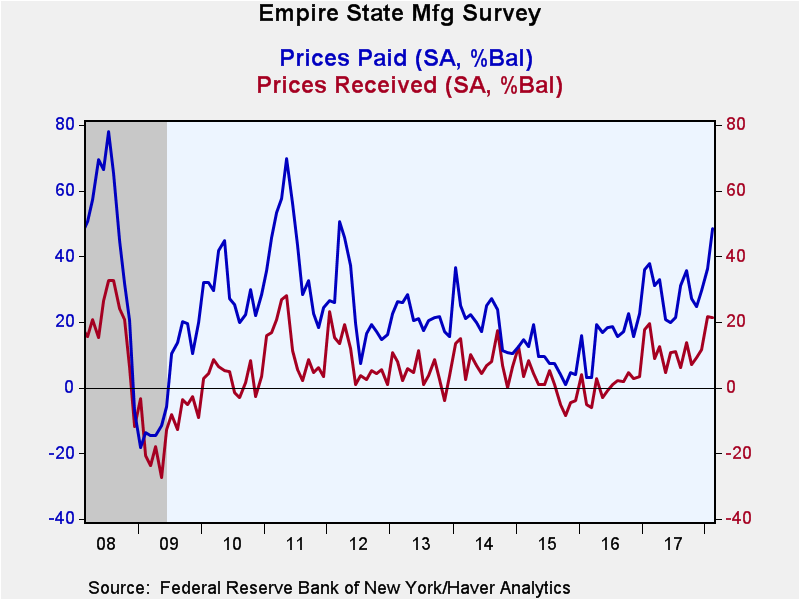 Global| Feb 15 2018
Global| Feb 15 2018Empire State Manufacturing Index Slides; Individual Components Mixed
Summary
The Empire State Manufacturing Index of General Business Conditions slid 4.6 points in February to 13.1, well below the median expectations of 18.0 from the in the Action Economics Forecast Survey. This is the lowest level since July [...]
The Empire State Manufacturing Index of General Business Conditions slid 4.6 points in February to 13.1, well below the median expectations of 18.0 from the in the Action Economics Forecast Survey. This is the lowest level since July 2017, but continues to indicate an expansion in factory sector activity. These data, reported by the Federal Reserve Bank of New York, reflect business conditions in New York, northern New Jersey and southern Connecticut.
The individual indices suggest a much more mixed picture than the headline statistic. Based on these figures, Haver Analytics calculates a seasonally adjusted index that is comparable to the ISM series. The calculated figure rose to 55.3 from 54.7. During the last ten years, the index had a 67% correlation with the quarter-on-quarter change in real GDP.
The number of employees showed healthy gains rebounding to 10.9. During the last ten years, there has been a 76% correlation between the employment index and the month-on-month change in factory sector payrolls. Nineteen percent of respondents reported a higher payroll level while eight percent reported a decline. The employee workweek reading increased to 4.6.
The new orders index rebounded a bit from its eight month low, while unfilled orders edged up. Delivery times showed a healthy gain. Meanwhile shipments declined to 12.5, its lowest level in six months. The volatile inventories index showed the biggest drop, falling 8.9 points.
The prices paid index had the largest gain jumping 12.4 points to 48.6, its highest level since March 2012. Fifty-one percent of respondents indicated paying higher prices, while just three percent reported them lower.
Expectations of business conditions increased to 50.5, the highest level since January 2012. The individual indices were much less sanguine with expected orders, employees, capital expenditures and prices received all down. Shipments were expected to be slightly higher.
The Empire State figures are diffusion indexes, which are calculated by subtracting the percent of respondents reporting declines from those reporting gains. The data are available in Haver's SURVEYS database. The ISM-adjusted headline index dates back to 2001. The Action Economics Forecasts can be found in Haver's AS1REPNA database.
| Empire State Manufacturing Survey | Feb | Jan | Dec | Feb'17 | 2017 | 2016 | 2015 |
|---|---|---|---|---|---|---|---|
| General Business Conditions (Diffusion Index, %, SA) | 13.1 | 17.7 | 19.6 | 17.1 | 16.1 | -2.6 | -2.3 |
| General Business Conditions Index (ISM Adjusted, >50=Increasing Activity, SA) | 55.3 | 54.7 | 57.1 | 53.8 | 54.6 | 48.2 | 48.8 |
| New Orders | 13.5 | 11.9 | 19.0 | 12.3 | 14.6 | -0.8 | -5.6 |
| Shipments | 12.5 | 14.4 | 23.5 | 14.7 | 15.9 | 1.9 | 4.0 |
| Unfilled Orders | 4.9 | 4.3 | -8.7 | 8.2 | 1.9 | -8.8 | -10.5 |
| Delivery Time | 11.1 | 3.6 | 4.3 | 7.1 | 6.1 | -4.8 | -5.3 |
| Inventories | 4.9 | 13.8 | 1.4 | 3.1 | 1.5 | -9.6 | -7.1 |
| Number of Employees | 10.9 | 3.8 | 22.9 | 0.8 | 8.3 | -5.1 | 2.3 |
| Average Employee Workweek | 4.6 | 0.8 | 9.3 | 3.3 | 4.9 | -5.2 | -4.8 |
| Prices Paid | 48.6 | 36.2 | 29.7 | 37.8 | 29.0 | 15.7 | 8.8 |
| Expectations 6 Months Ahead | 50.5 | 48.6 | 46.3 | 41.3 | 42.6 | 29.0 | 30.3 |
Gerald D. Cohen
AuthorMore in Author Profile »Gerald Cohen provides strategic vision and leadership of the translational economic research and policy initiatives at the Kenan Institute of Private Enterprise.
He has worked in both the public and private sectors focusing on the intersection between financial markets and economic fundamentals. He was a Senior Economist at Haver Analytics from January 2019 to February 2021. During the Obama Administration Gerald was Deputy Assistant Secretary for Macroeconomic Analysis at the U.S. Department of Treasury where he helped formulate and evaluate the impact of policy proposals on the U.S. economy. Prior to Treasury, he co-managed a global macro fund at Ziff Brothers Investments.
Gerald holds a bachelor’s of science from the Massachusetts Institute of Technology and a Ph.D. in Economics from Harvard University and is a contributing author to 30-Second Money as well as a co-author of Political Cycles and the Macroeconomy.









